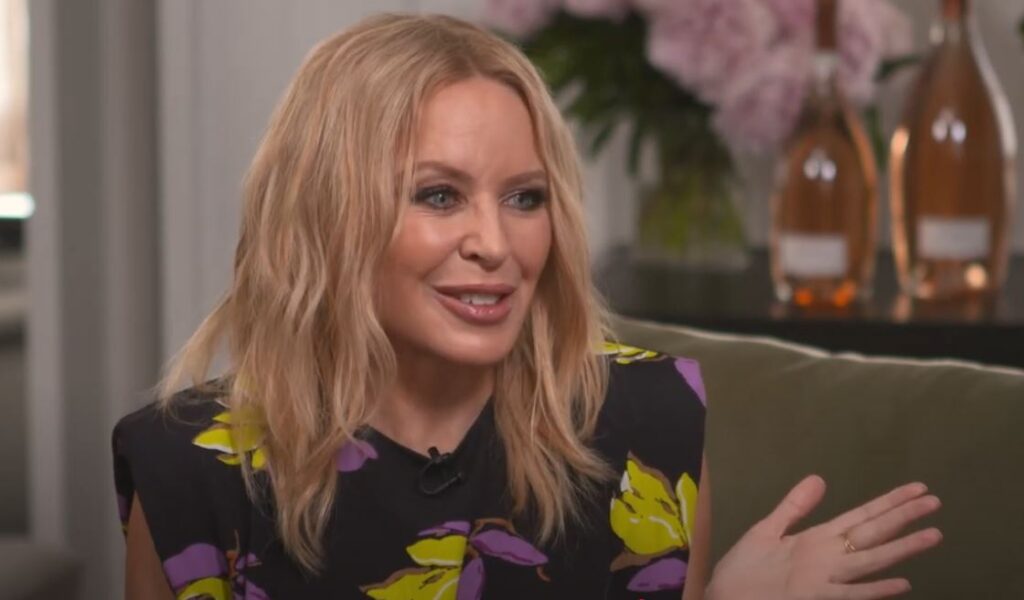The story of Kylie Minogue’s transformation from a teenage soap opera star to a major force in music and business is one that is still developing, albeit quietly. Her estimated net worth as of 2025 is an astounding $130 million, a sum that is based on more than just glitzy costumes and catchy hooks. Her wealth, maintained over five decades, is a testament to astute investing, strategic reinvention, and an underappreciated entrepreneurial flair.
Kylie made a meager £150 per episode of Neighbours back in the mid-1980s. But the show’s widespread appeal, especially in the UK, put her on a very profitable path. A surprise demo deal resulted from her duet performance at a local football benefit, and by the summer of 1987, “The Loco-Motion” had broken all previous records in Australia. Captured and exploited, that one moment signaled the start of a revenue stream that would thrive for decades.
Kylie Minogue: Career and Financial Overview
| Detail | Information |
|---|---|
| Full Name | Kylie Ann Minogue |
| Birth Date | May 28, 1968 |
| Birthplace | Melbourne, Australia |
| Nationality | Australian and British |
| Main Professions | Singer, Actress, Businesswoman |
| Active Years | 1979 to present |
| Estimated Net Worth (2025) | $120–130 million |
| Best-Selling Albums | Fever, Kylie, Light Years, Tension |
| Major Hits | “Can’t Get You Out of My Head,” “Spinning Around,” “The Loco-Motion” |
| Awards | 2 Grammys, 4 Brit Awards, 18 ARIA Awards |
| Real Estate Highlight | $25M apartment in London’s One Hyde Park |
She went from being a TV idol to a global pop sensation by working with Stock Aitken Waterman. In addition to being a successful debut album, Kylie went on to become the best-selling album by a female artist in the UK in the 1980s. With an estimated five million copies sold, the record immediately put her in a high-earning bracket. The kind of career shocks typically reserved for celebrities like Britney Spears or Justin Timberlake were echoed by this incredibly successful debut.
The 1990s saw a significant change in Kylie’s income. She experimented with alternative and more mature music genres, but the commercial outcomes were mixed. Her ability to change course, however, worked incredibly well. When she signed with Parlophone in 1999, she returned to dance-pop’s mainstream spotlight. The lead single from Fever (2001), “Can’t Get You Out of My Head,” sold over five million copies, solidifying her worldwide fame and bringing in music and licensing revenue that greatly increased her personal wealth.
Another very obvious factor in creating Kylie’s financial legacy was touring. Just her tour, Aphrodite: Les Folies, brought in over $60 million. Each tour, which frequently traveled across continents, generated seven to eight-figure profits starting in 2000. When streaming started to affect physical music sales, she was able to keep up her momentum thanks to these high-yield performances that complemented her album cycles. With the possible exception of Beyoncé and Madonna, few female pop artists have consistently generated this amount of money from ticket sales.
Kylie’s income diversification over the last ten years is remarkably similar to that of successful lifestyle entrepreneurs. She went beyond music by starting her own bedding and fragrance lines. Her lingerie campaigns, particularly with Agent Provocateur, were not only daring but also profitable, and her perfume “Darling” became an unexpected hit in Australia. Her brand gained depth as a result of these endeavors, which helped her maintain her commercial relevance without being overly dominated by the media.
Her financial stability has also significantly improved as a result of her involvement in real estate. Although she owns a number of homes, her apartment in London’s One Hyde Park—a complex renowned for its elite status and billionaire residents—is the most opulent. At more than $25 million, it is a glaring example of her astute investment sense. She has also purchased and sold real estate in Australia and Spain, including a beachfront house close to Barcelona that she used while undergoing treatment for breast cancer.
Kylie’s tour break during her 2005 cancer battle enhanced rather than diminished her brand. Loyalty resulted from the emotional depth that was added to her public persona. She made over $40 million when she returned with Showgirl: The Homecoming Tour. She established herself as resilient and relatable by candidly sharing her story and resuming her career with vigor, qualities that directly boosted her marketability.
Kylie Jenner’s attempt to trademark “Kylie” for commercial use was successfully contested by Minogue in a highly publicized legal episode. Her representatives stressed that she had owned the domain www.kylie.com since 1996, had been known by that name in public for decades, and had long linked her name to fashion, music, and fragrance. The outcome? a court ruling that safeguarded her brand equity and intellectual property, which are underappreciated but extremely significant assets in the modern brand economy.
Kylie continues to perform at festivals, put out new albums, and make appearances in movies and television shows, despite the fact that younger pop stars are vying for digital virality. She is extremely valuable due to her versatility. Her varied media presence, which includes appearances in Moulin Rouge! and Doctor Who, supports both her global visibility and recurring revenue streams. She has even talked about creating a musical based on her songs in recent years—another avenue that has the potential to be both financially successful and culturally significant.

